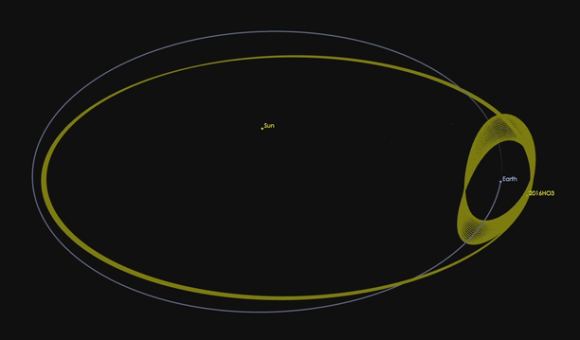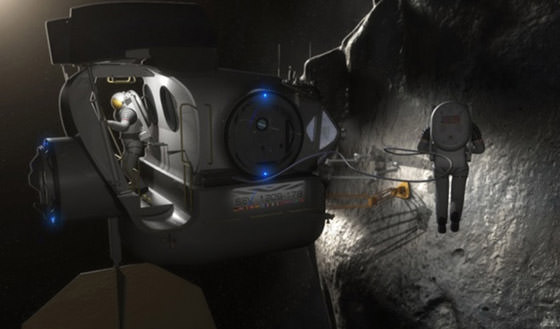In April of 2016, astronomers became aware of a distant object that appeared to be orbiting the Sun, but was also passing close enough to Earth that it could be periodically viewed using the most powerful telescopes. Since then, there has been ample speculation as to what this “Temporary Moon” could be, with most astronomers claiming that it is likely nothing more than an asteroid.
However, some suggested that it was a burnt-out rocket booster trapped in a near-Earth orbit. But thanks to new study by a team from the University of Arizona’s Lunar and Planetary Laboratory, this object – known as (469219) 2016 HO3 – has been confirmed as an asteroid. While this small near-Earth-asteroid orbits the Sun, it also orbits Earth as a sort of “quasi-satellite”.
The team that made this discovery was led by Vishnu Reddy, an assistant professor at the University of Arizona’s Lunar and Planetary Laboratory. Their research was also made possible thanks to NASA’s Near-Earth Object Observations Program. This program is maintained by NASA’s Center for Near-Earth Object Studies (CNEOS) and provides grants to institutions dedicated to the research of NEOs.

The details of this discovery were presented this week at the 49th Annual Meeting of the Division for Planetary Sciences in Utah at a presentation titled “Ground-based Characterization of Earth Quasi Satellite (469219) 2016 HO3”. During the course of the presentation, Reddy and his colleagues described how they spotted the object using the Large Binocular Telescope (LBT) at the LBT Observatory on Mount Graham in southeastern Arizona.
According to their observations, 2016 HO3 measures just 100 meters (330 feet) across and is the most stable quasi-satellite discovered to date (of which there have been five). Over the course of a few centuries, this asteroid remains at a distance of 38 to 100 lunar distances – i.e. the distance between the Earth and the Moon. As Reddy explained in a UANews press statement, this makes the asteroid a challenging target:
“While HO3 is close to the Earth, its small size – possibly not larger than 100 feet – makes it challenging target to study. Our observations show that HO3 rotates once every 28 minutes and is made of materials similar to asteroids.”
Discovering the true nature of this object has also solved another big question – namely, where did 2016 HO3 come from? For those speculating that it might be space junk, it then became necessary to determine what the likely source of that junk was. Was it a remnant of an Apollo-era mission, or something else entirely? By determining that it is actually an NEO, Reddy and his team have indicted that it likely comes from the same place as other NEOs.

Reddy and his colleagues also indicated that 2016 HO3 reflected light off its surface in a way that is similar to meteorites that have been studied here on Earth. This was another indication that 2016 HO3 has similar origins to other NEOs (some of which have entered our atmosphere as meteors) which are generally asteroids that were kicked out of the Main Belt by Jupiter’s gravity.
“In an effort to constrain its rotation period and surface composition, we observed 2016 HO3 on April 14 and 18 with the Large Binocular Telescope and the Discovery Channel Telescope,” Reddy said. “The derived rotation period and the spectrum of emitted light are not uncommon among small NEOs, suggesting that 2016 HO3 is a natural object of similar provenance to other small NEOs.”
But unlike other NEOs which periodically cross Earth’s orbit, “quasi-satellites” are distinguished by their rather unique orbits. In the case of 2016 HO3, it has an orbit that follows a similar path to that the Earth’s; but because it is not dominated by the Earth’s gravity, their two orbits are out of sync. This causes 2016 HO3 to make annual loops around the Earth as it orbits the Sun.

Christian Veillet, one of co-authors of the presentation, is also the director of the LBT Observatory. As he explained, this characteristic could make “quasi-satellites” ideal targets for future NEO studies:
“Of the near-Earth objects we know of, these types of objects would be the easiest to reach, so they could potentially make suitable targets for exploration. With its binocular arrangement of two 8.4-meter mirrors, coupled with a very efficient pair of imagers and spectrographs like MODS, LBT is ideally suited to the characterization of these Earth’s companions.”
Similarly, their orbital characteristic could make “quasi-satellites” an ideal target for future space missions. One of NASA’s main goals in the coming decade is to send a crewed mission to a Near-Earth Object in order to test the Orion spacecraft and the Space Launch System. Such a mission would also help develop the necessary expertise for mounting missions deeper into space (i.e. to Mars and beyond).
The study of Near-Earth Objects is also of immense importance when it comes to determining how and where as asteroid might pose a threat to Earth. This knowledge allows for advanced warnings which can potentially save lives. It is also significant when it comes to the development of proposed counter-measures, several of which are currently being explored.
And be sure to enjoy this video of 2016 HO3’s orbit, courtesy of NASA’s Jet Propulsion Laboratory:
Further Reading: UANews

